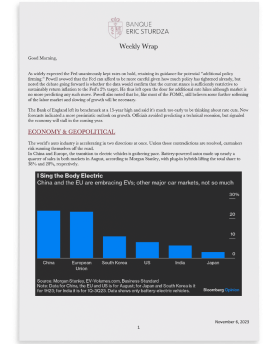When history rhymes…
In the not-too-distant past, when Alan Greenspan was still playing the Sphynx at the Federal Reserve, the Fed model was very much in vogue. Younger readers who have only been following the markets for a couple of decades may be unfamiliar with this partially obsolete concept. The idea behind the Fed model was to compare the S&P500 earnings yield* with the US 10-year yield. This provided an indication of the relative attractiveness of one asset class versus another. When 10-year yields are higher than earnings yields, bonds are more attractive than equities; when they are lower than earnings yields, equities should be preferred. In the short term, the crossover between earning yields and 10-year yields surely sends a cautious message: US equities have gone a little too fast compared with fixed income and we could see a return to the mean. It also reflects the fact that the S&P500 behaved like a two-speed market: to the stellar performances of the Magnificent 7 – or should we say Magnificent 5 – we could oppose the more mixed results of the rest of US markets. In the longer term, the picture is more varied: the weakness of the US fixed income market, and the fact that US Treasuries are reacting less effectively as a “risk-off” asset, points to a more structural reality: the level of US indebtedness, hitherto unaffected by the appetite of debt buyers, is approaching a threshold that prompts more circumspection about government bonds, especially at a time inflation fears could make a comeback. We are detailing these ideas in this newsletter.




